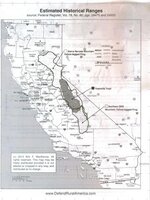Upvote
0
You are using an out of date browser. It may not display this or other websites correctly.
You should upgrade or use an alternative browser.
You should upgrade or use an alternative browser.
WANT TO FIGHT BACK?
- Thread starter Fullpan
- Start date
- Thread starter
- #21
BOS Main Info
This is main page of ElDorado county Board of Supervisers - the 5 district members are listed on left of page. This is just one
of many counties affected.
This is main page of ElDorado county Board of Supervisers - the 5 district members are listed on left of page. This is just one
of many counties affected.
Last edited:
Alex Burke
Hero Member
Cool thanks for the update Hefty1. Is there a main association representing all of us who oppose these type of measures? Is DRA the biggest or are there diff mining and other groups all fighting these and different land grab initiatives. I'm sure if we beat this one another will follow. I'm trying to understand who lobbies for us best and where efforts are best applied, do we have lobbyists in DC or even 1 lol? I'm fairly new to this cause, I'd assume big mining companies would have lobbyists but I don't understand who represents small time miners, ATV users, boaters, fisherman, weekend prospectors etc. it seems fragmented am I right? I had a ticket but had to stay home, I really wanted to learn more. Thanks for any replies.
Just saw your post Fullpan I'll call on monday for sure.
Just saw your post Fullpan I'll call on monday for sure.

Last edited:
BOS Main Info
This is main page of ElDorado county Board of Supervisers - the 5 district members are listed on left of page. This is just one
of many counties affected.
Actually Fullpan Eldorado County is the only county that has already set their opposition against the frog land grab.
Cool thanks for the update Hefty1. Is there a main association representing all of us who oppose these type of measures? Is DRA the biggest or are there diff mining and other groups all fighting these and different land grab initiatives. I'm sure if we beat this one another will follow. I'm trying to understand who lobbies for us best and where efforts are best applied, do we have lobbyists in DC or even 1 lol? I'm fairly new to this cause, I'd assume big mining companies would have lobbyists but I don't understand who represents small time miners, ATV users, boaters, fisherman, weekend prospectors etc. it seems fragmented am I right? I had a ticket but had to stay home, I really wanted to learn more. Thanks for any replies.
Just saw your post Fullpan I'll call on monday for sure.
Western Mining Assoc, PLP, CABPRO, and others.
63bkpkr
Silver Member
- Aug 9, 2007
- 4,069
- 4,618
- Detector(s) used
- XLT, GMT, 6000D Coinmaster
- Primary Interest:
- All Treasure Hunting
I am just adding on to Hefty1's inputs:
I attended a meeting in Auburn CA and have Just returned from it. Six different but loosely related groups were each represented by 'A' speaker and clearly and legally pointed out to the audience how county, state and federal officers that have sworn an oath to uphold the laws of this country have broken that oath and at least these three agencies are advancing Agenda 21 and in doing so have made a pact with a foreign entity to dislodge and destroy the government of this our Republic. The group Defend Rural America worked to bring together the speakers for the other five organizations and what they presented were some shattering facts of how the government of the U.S. is working to bankrupt the country, give total control of food production, energy production, land use, water availability to those who would destabilize this government and allow a world order to control all of us.
This amounts to Facisim and tyranny perpetrated by our elected government officials to overthrow this country.
The presenters represented: Western Mining Assoc, PLP, CABPRO, DRA(Defend Rural America), Calforests, and ?, somebody else will need to fill in the final organization. Quite a meeting indeed! This group presentation was there to inform the public at large and to get us to understand that if we keep working at it starting at the County Level we can start to halt these land grabs! Send letters to the counties involved, there are 14, requesting that they not agree to yield any lands to this Save the Frog and Toad farse.
There should be some information posted soon on the Defend Rural America.com website that could aid in your letter writing. Specifics, actual items, actual costs/losses, loss of property and/or property values - all of this would be related to the Initial Requst to withdraw the use of some 2 million acres in order to save the Frogs and Toads. Initial means that this is only the start as buffer zones are likely to be added onto this initial amount so the final figure Could be 5 to 7 million acres withdrawn. If you own land in this zone, tough luck. Oh, and IF they get their way then further additions/changes can be made without notifying We The People.
It is time to put a stop to all of these illegal actions and the time to do something about it is NOW! There are 14 Northern California Counties within this withdraw area. Go online, get the information on the counties and write including specifics as outlined above.............................63bkpkr
I attended a meeting in Auburn CA and have Just returned from it. Six different but loosely related groups were each represented by 'A' speaker and clearly and legally pointed out to the audience how county, state and federal officers that have sworn an oath to uphold the laws of this country have broken that oath and at least these three agencies are advancing Agenda 21 and in doing so have made a pact with a foreign entity to dislodge and destroy the government of this our Republic. The group Defend Rural America worked to bring together the speakers for the other five organizations and what they presented were some shattering facts of how the government of the U.S. is working to bankrupt the country, give total control of food production, energy production, land use, water availability to those who would destabilize this government and allow a world order to control all of us.
This amounts to Facisim and tyranny perpetrated by our elected government officials to overthrow this country.
The presenters represented: Western Mining Assoc, PLP, CABPRO, DRA(Defend Rural America), Calforests, and ?, somebody else will need to fill in the final organization. Quite a meeting indeed! This group presentation was there to inform the public at large and to get us to understand that if we keep working at it starting at the County Level we can start to halt these land grabs! Send letters to the counties involved, there are 14, requesting that they not agree to yield any lands to this Save the Frog and Toad farse.
There should be some information posted soon on the Defend Rural America.com website that could aid in your letter writing. Specifics, actual items, actual costs/losses, loss of property and/or property values - all of this would be related to the Initial Requst to withdraw the use of some 2 million acres in order to save the Frogs and Toads. Initial means that this is only the start as buffer zones are likely to be added onto this initial amount so the final figure Could be 5 to 7 million acres withdrawn. If you own land in this zone, tough luck. Oh, and IF they get their way then further additions/changes can be made without notifying We The People.
It is time to put a stop to all of these illegal actions and the time to do something about it is NOW! There are 14 Northern California Counties within this withdraw area. Go online, get the information on the counties and write including specifics as outlined above.............................63bkpkr
Last edited:
Alex Burke
Hero Member
Well I guess I'll continue to research where I can mine gold elsewhere in the world, seems to be a wrap here lol, we got a whole 10 comments or something there's a few weeks to go but kind of deflating, sorry I didn't make it too thanks for going.
63bkpkr
Silver Member
- Aug 9, 2007
- 4,069
- 4,618
- Detector(s) used
- XLT, GMT, 6000D Coinmaster
- Primary Interest:
- All Treasure Hunting
MeteorMiner, yes it is a shock to understand what is being done to us but Do Not Give Up as the fight is not over yet. Yes only a few days left to write and be counted but writing IS the thing to do. So many Americans, if they can be called that, do not vote, now is the time for us to vote by writing to the counties!
Hefty has supplied the guide lines to writing about these issues, read the information he has supplied, write your letters and mail them so they are received before the deadline.
If WE expect to be free in the future then we need to Respond NOW!.........................63bkpkr
Hefty has supplied the guide lines to writing about these issues, read the information he has supplied, write your letters and mail them so they are received before the deadline.
If WE expect to be free in the future then we need to Respond NOW!.........................63bkpkr
Sample Pan Dan
Bronze Member
Think they will question the San Diego post mark? Too damn bad! Sending out a handful tomorrow anyway.
Alex Burke
Hero Member
I'm going to write to them I am just being realistic lol. We can't even run a small dredge so mining is just for fun at this point in our state, I might as well fish the equipment is lighter, unless you have a great claim it's hard to move the material at a good rate.
Last edited:
Alex Burke
Hero Member
Think they will question the San Diego post mark? Too damn bad! Sending out a handful tomorrow anyway.
Hi drywallman just email them then you can copy paste and do it for free.
Sample Pan Dan
Bronze Member
Thanks
Just emailed all BOS in placer county...with a CC of [email protected]
See if I get any replys...waiting game now.
See if I get any replys...waiting game now.
Hi drywallman just email them then you can copy paste and do it for free.
Sometimes all you can find is their Aids email...use them. We need to pound these people HARD!!!
I wonder how this went for the little varmints 3 yrs ago?
And once common in southern Ca. what the heck do they want to take all the land up here for?
Mountain yellow-legged frogs reintroduced to wild
Released: 4/16/2010 9:08:16 AM
In partnership with: San Diego Zoo, U.S. Fish and Wildlife Service, U.S. Forest Service, California Fish Game, James San Jacinto Mountains Reserve
And once common in southern Ca. what the heck do they want to take all the land up here for?
Mountain yellow-legged frogs reintroduced to wild
Released: 4/16/2010 9:08:16 AM
| Contact Information: U.S. Department of the Interior, U.S. Geological Survey Office of Communication 119 National Center Reston, VA 20192 | Adam Backlin (USGS) http://www.usgs.gov/newsroom/[email protected]&n=Adam+Backlin+(USGS) Phone: 714-508-4702 Dani Dodge Medlin (San Diego Zoo) Phone: 619-685-3291 Becca Fenwick (James Reserve) Phone: 951-827-6835 |
| | |
In partnership with: San Diego Zoo, U.S. Fish and Wildlife Service, U.S. Forest Service, California Fish Game, James San Jacinto Mountains Reserve
The endangered mountain yellow-legged frog will take a major step in its recovery this week when, for the first time, scientists reintroduce its eggs to its former habitat. This reintroduction will occur at University of California Riverside’s James San Jacinto Mountains Reserve, part of the UC Natural Reserve System, and will be done in collaboration with the U.S. Geological Survey, U.S. Forest Service, U.S. Fish and Wildlife Service, the San Diego Zoo Institute for Conservation Research and the California Department of Fish and Game.
In 2006, scientists collected mountain yellow-legged frog tadpoles from the remaining wild populations in the San Jacinto Mountains and took them to the San Diego Zoo Institute for Conservation Research where, for the first time, specialists were able to establish a captive breeding program for the species. This year’s reproductive season at the Zoo has been so successful that scientists have decided to attempt a reintroduction into the wild. There are 61 mountain yellow-legged frogs at the San Diego Zoo Institute for Conservation Research. Scientists attempted to spur breeding in January by putting half of that population into a cooler that mimicked high mountain winter conditions. The chill caused the frogs to hibernate. About two weeks ago the frogs were taken out of the coolers and began displaying breeding behaviors within a few days. “Three months ago the San Diego Zoo started an experimental procedure of chilling these frogs to see how it would effect breeding. It has been wildly successful and as a result today we can reintroduce about 500 eggs into the San Jacinto Mountains,” said Jeff Lemm Research Coordinator for the San Diego Zoo Institute for Conservation Research. “This is a momentous day—the first ever reintroduction of these endangered frog eggs back into their natural habitat and the San Diego Zoo is thrilled to be a part of it”. The James San Jacinto Mountains Reserve was selected for this reintroduction because it is a protected area with ideal habitats in the species’ former range. The mountain yellow-legged frog is one of three Southern California frog or toad species on the Federal Endangered Species List. Biologists from the USGS will be responsible for the initial phase of the reintroduction, and will be releasing egg masses into deep permanent pools, followed by the additional release of tadpoles later in the year. They will then closely monitor the health and success of the reintroduction. It will take two years for the tadpoles to morph into adults and as they are not a migratory species, the frogs will stay in the creek within the bounds of the protected reserve where they can be easily monitored. “This is an amazing first step in the recovery program for this wonderful frog, and we are looking forward to having the frogs here for a long time to come,” said Becca Fenwick, Director of the James San Jacinto Mountains Reserve. The James San Jacinto Mountains Reserve is one of thirty-seven University of California reserves throughout the state protecting over 280,000 acres, and making them available for research, university level instruction and public outreach. www.jamesreserve.edu U.S. Fish and Wildlife Service is working with others to conserve, protect and enhance fish, wildlife, plants and their habitats for the continuing benefit of the American people. The San Diego Zoo’s Institute for Conservation Research is dedicated to generating, sharing and applying scientific knowledge vital to the conservation of animals, plants and habitats worldwide. |
Sample Pan Dan
Bronze Member
****! That means they'll start working on land grabs in so cal next. :-(
- Thread starter
- #40
I wonder how this went for the little varmints 3 yrs ago?
And once common in southern Ca. what the heck do they want to take all the land up here for?
Mountain yellow-legged frogs reintroduced to wild
Released: 4/16/2010 9:08:16 AM
Contact Information:
U.S. Department of the Interior, U.S. Geological Survey
Office of Communication
119 National Center
Reston, VA 20192
Adam Backlin (USGS) http://www.usgs.gov/newsroom/[email protected]&n=Adam+Backlin+(USGS)
Phone: 714-508-4702
Dani Dodge Medlin (San Diego Zoo)
Phone: 619-685-3291
Becca Fenwick (James Reserve)
Phone: 951-827-6835
In partnership with: San Diego Zoo, U.S. Fish and Wildlife Service, U.S. Forest Service, California Fish Game, James San Jacinto Mountains Reserve
The endangered mountain yellow-legged frog will take a major step in its recovery this week when, for the first time, scientists reintroduce its eggs to its former habitat. This reintroduction will occur at University of California Riverside’s James San Jacinto Mountains Reserve, part of the UC Natural Reserve System, and will be done in collaboration with the U.S. Geological Survey, U.S. Forest Service, U.S. Fish and Wildlife Service, the San Diego Zoo Institute for Conservation Research and the California Department of Fish and Game.
Once common throughout much of southern California, the mountain yellow-legged frog has been decreasing in numbers since the 1970s due to what scientists call the “perfect storm” that is affecting frog populations around the globe—decreasing habitat, increasing pollution and invasive species, the spread of the deadly chytrid fungus and the effects of climate change. Today, only a small wild population of less than 200 individuals can be found in the San Gabriel, San Bernardino, and San Jacinto Mountains.
http://gallery.usgs.gov/photos/07_23_2009_y17Gx33wvq_07_23_2009_0
USGS scientists found this adult mountain yellow-legged frog on June 10 in Tahquitz Creek, a rediscovered population of the endangered frog in the San Jacinto Wilderness, San Bernardino National Forest, California.
In 2006, scientists collected mountain yellow-legged frog tadpoles from the remaining wild populations in the San Jacinto Mountains and took them to the San Diego Zoo Institute for Conservation Research where, for the first time, specialists were able to establish a captive breeding program for the species. This year’s reproductive season at the Zoo has been so successful that scientists have decided to attempt a reintroduction into the wild.
There are 61 mountain yellow-legged frogs at the San Diego Zoo Institute for Conservation Research. Scientists attempted to spur breeding in January by putting half of that population into a cooler that mimicked high mountain winter conditions. The chill caused the frogs to hibernate. About two weeks ago the frogs were taken out of the coolers and began displaying breeding behaviors within a few days. “Three months ago the San Diego Zoo started an experimental procedure of chilling these frogs to see how it would effect breeding. It has been wildly successful and as a result today we can reintroduce about 500 eggs into the San Jacinto Mountains,” said Jeff Lemm Research Coordinator for the San Diego Zoo Institute for Conservation Research. “This is a momentous day—the first ever reintroduction of these endangered frog eggs back into their natural habitat and the San Diego Zoo is thrilled to be a part of it”. The James San Jacinto Mountains Reserve was selected for this reintroduction because it is a protected area with ideal habitats in the species’ former range.
The mountain yellow-legged frog is one of three Southern California frog or toad species on the Federal Endangered Species List. Biologists from the USGS will be responsible for the initial phase of the reintroduction, and will be releasing egg masses into deep permanent pools, followed by the additional release of tadpoles later in the year. They will then closely monitor the health and success of the reintroduction. It will take two years for the tadpoles to morph into adults and as they are not a migratory species, the frogs will stay in the creek within the bounds of the protected reserve where they can be easily monitored. “This is an amazing first step in the recovery program for this wonderful frog, and we are looking forward to having the frogs here for a long time to come,” said Becca Fenwick, Director of the James San Jacinto Mountains Reserve.
The James San Jacinto Mountains Reserve is one of thirty-seven University of California reserves throughout the state protecting over 280,000 acres, and making them available for research, university level instruction and public outreach. www.jamesreserve.edu
U.S. Fish and Wildlife Service is working with others to conserve, protect and enhance fish, wildlife, plants and their habitats for the continuing benefit of the American people.
The San Diego Zoo’s Institute for Conservation Research is dedicated to generating, sharing and applying scientific knowledge vital to the conservation of animals, plants and habitats worldwide.
Thanks again hefty1 - this needs to be sent to the Mountain Democrat newspaper, who just ran a story about El Dorado co. requesting a field meeting with the Fish and Wildlife Service on the frog thing.
Top Member Reactions
-
 2283
2283 -
 1105
1105 -
 1029
1029 -
 909
909 -
 857
857 -
 764
764 -
 754
754 -
 735
735 -
 607
607 -
 505
505 -
 492
492 -
 478
478 -
 432
432 -
 420
420 -
 406
406 -
O
403
-
 401
401 -
 394
394 -
 378
378 -
 374
374
Users who are viewing this thread
Total: 2 (members: 0, guests: 2)







